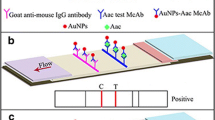Abstract
Polyclonal and monoclonal antibodies (PCAs and MCAs), produced to whole cells and flagellar extracts ofXanthomonas campestris pv.campestris (Xcc), respectively, were tested for specificity. In immunofluorescence microscopy (IF) the three PCAs tested, reacted at low dilutions with all Xcc strains, some other xanthomonads and non-xanthomonads. At higher dilutions most cross-reactivity with non-xanthomonad strains disappeared. However, the cross-reactivity with strains ofX. c. pv.vesicatoria (Xcv),X. c. pv.amoraciae (Xca) andX. c. pv.phaseoli var. fuscans (Xcpf) remained.
Six MCA-producing cell clones viz. 20H6, 2F4, 18G12, 10C5, 17C12 and 16B5 were selected for specificity tests with an enzyme immunoassay (EIA), IF and a dot-blot immunoassay (DBI). None of the MCAs reacted with all Xcc strains in IF and EIA. In DBI, only MCAs 17C12 and 16B5 reacted with all Xcc strains. All six MCAs tested, cross-reacted in one of either tests with other pathovars ofX. campestris, such as Xcv or Xca. The MCAs were also tested in immunoblotting experiments using total bacterial extracts, cell envelope and flagellar extracts. MCAs 20H6, 2F4, 18G12 and 10C5 reacted with the lipopolysaccharide (LPS) of Xcc. MCAs 16B5 and 17C12 reacted with a 39 kilodalton and a 29 kilodalton protein, respectively.
It is concluded that the PCAs and MCAs discussed in this study may be used for routine identification and differentiation of (a group of) Xcc strains. The significance of the cross-reactions with other pathovars ofX. campestris needs to be determined by testing seed lots.
Similar content being viewed by others
References
Alvarez, A.M. & Lou, K., 1985. Rapid identification ofXanthomonas campestris pv.campestris by ELISA. Plant Disease 69: 1082–1086.
Alvarez A.M., Benedict, A.A. & Mizumoto, C.Y., 1985. Identification of xanthomonads and grouping of strains ofXanthomonas campestris pv.campestris with monoclonal antibodies. Phytopathology 75: 722–728.
Benedict, A.A., Alvarez, A.M., Berestecky, J., Imanaka, W., Mizumoto, C.Y., Pollard, L.W., Mew, T.W. & Gonzalez, C.F., 1989. Pathovar-specific monoclonal antibodies forXanthomonas campestris pv.oryzae and forXanthomonas campestris pv.oryzicola. Phytopathology 79: 322–328.
Benedict, A.A., Alvarez, A.M. & Pollard, L.W., 1990. Pathovar-specific antigens ofXanthomonas campestris pv. begoniae andX. campestris pv.pelargonii detected with monoclonal antibodies. Applied and Environmental Microbiology, 56: 572–574.
Boonekamp, P.M., Pomp, H. & Gussenhoven, G.C., 1990. Production and characterization of monoclonal antibodies to potato virus A. Journal of Phytopathology 128: 112–124.
Clark, M.F. & Adams, A.N., 1977. Characteristics of the microplate method of enzyme-linked immunosorbent assay for the detection of plant viruses. Journal of General Virology 34: 475–483.
De Boer, S.H. & McNaughton, M.E., 1987. Monoclonal antibodies to the lipopolysaccharide ofErwinia carotovora subsp.atroseptica serogroup I. Phytopathology 77: 828–832.
De Weger, L.A., Jann, B., Jann, K. & Lugtenberg, B., 1987. Lipopolysaccharides ofPseudomonas spp. that stimulate plant growth: composition and use for strain identification. Journal of Bacteriology 169: 1441–1446.
El-Sharkawy, T.A. & Huisingh, D., 1971. Differentiation amongXanthomonas species by polyacrylamide gel electrophoresis of soluble proteins. Journal of General Microbiology 68: 155–165.
Franken, A.A.J.M. & Van Vuurde, J.W.L., 1990. Problems and new approaches in the use of serology for seed-borne bacteria. Seed Science and Technology 18: 415–426.
Haaheim, L.R., Kleppe, G. & Sutherland, I.W., 1989. Monoclonal antibodies reacting with the exopolysaccharide xanthan fromXanthomonas campestris. Journal of General Microbiology 135: 605–612.
Jones, J.B. & Van Vuurde, J.W.L., 1989. Monoclonal antibodies (MAs) againstXanthomonas campestris pv.begoniae (XCB) andpelargonii (XCP). Phytopathology 79: 1178 (Abstr.).
Kiredjian, M., Holmes, B., Kersters, K., Guilvout, I. & De Ley, J., 1986.Alcaligenes piechaudii, a new species from human clinical specimens and the environment. International Journal of Systematic Bacteriology 36: 282–287.
Laakso, T., Ojanen, T., Helander, I.M., Karjalainen, R., Korhonen, T.K. & Haahtela, K., 1990. Comparison of outer membrane proteins and lipopolysaccharides ofXanthomonas campestris pathovars. Proceedings of the 7th International Conference on Plant Pathogenic Bacteria: 149–154.
Laemmli, U.K., 1970. Cleavage of structural proteins during the assembly of the head of bacteriophage T4. Nature 227: 680–685.
Martin, J.H. & Savage, D.C., 1985. Purification and characterization of flagella fromRoseburia cecicola, an obligately anaerobic bacterium. Journal of General Microbiology 131: 2075–2078.
Minsavage, G.V. & Schaad, N.W., 1983. Characterization of membrane proteins ofXanthomonas campestris pv.campestris. Phytopathology 73: 747–755.
Roitt I., 1988. Essential Immunology. Blackwell Scientific Publications, London pp. 286.
Schaad, N.W., 1978. Use of direct and indirect immunofluorescence tests for identification ofXanthomonas campestris pv.campestris. Phytopathology 68: 249–252.
Tsai, C.M. & Frasch, C.E., 1982. A sensitive silver stain for detecting lipopolysaccharides in polyacrylamide gels. Analytical Biochemistry 119: 115–119.
Van Vuurde, J.W.J., Van den Bovenkamp, G.W. & Birnbaum, Y., 1983. Immunofluorescence microscopy and enzyme-linked immunosorbent assay as potential routine tests for the detection ofPseudomonas syringae pv.phaseolicola andXanthomonas campestris pv.phaseoli in bean seed. Seed Science and Technology 11: 547–559.
Williams, P.H., 1980. A continuing threat to world crucifers. Plant Disease 64: 736–742.
Yuen, G.Y., Alvarez, A.M., Benedict, A.A., & Trotter, K.J., 1987. Use of monoclonal antibodies to monitor the dissemination ofXanthomonas campestris pv.campestris. Phytopathology 77: 366–370.
Author information
Authors and Affiliations
Rights and permissions
About this article
Cite this article
Franken, A.A.J.M., Zilverentant, J.F., Boonekamp, P.M. et al. Specificity of polycllonal and monoclonal antibodies for the identification of Xanthomonas campestris pv. campestris. Netherlands Journal of Plant Pathology 98, 81–94 (1992). https://doi.org/10.1007/BF01996321
Accepted:
Issue Date:
DOI: https://doi.org/10.1007/BF01996321




